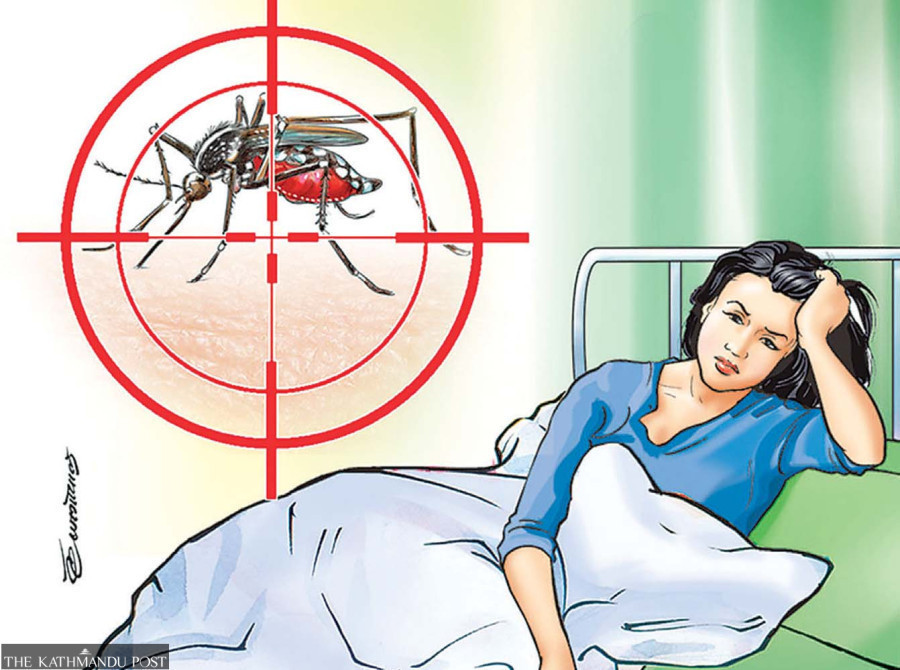Health
Dengue cases spike in Kathmandu. 18 people getting infected daily
Doctors say actual numbers are likely higher because only 18 government health facilities are providing data.
Post Report
As heavy monsoon rains cause chaos across the country, dengue cases are surging in several districts, including Kathmandu.
According to the Health Office Kathmandu, around 18 people are infected with the dengue virus every day. Officials, however, admit that this number could be just the tip of the iceberg, as the office gets reports only from 18 health facilities.
“Yes, the number of people infected with the dengue virus could be several times higher than suggested by the reports we are getting every day,” said Dr Arjun Sapkota, chief of the Health Office, Kathmandu. “We are working to make daily reporting of dengue cases mandatory for private health facilities as well.”
Dengue is a viral disease transmitted by female Aedes aegypti and Aedes albopictus mosquitoes. The same vectors also transmit chikungunya, yellow fever, and Zika virus, according to the World Health Organisation.
According to data provided by the Epidemiology and Disease Control Division, at least 1,432 people from 73 districts have been infected with the virus since January this year. Among the 73 districts that reported dengue outbreaks, Kathmandu has the highest number of cases with 159, followed by Jhapa with 120, Chitwan 83, Makawanpur 65, Tanahun and Doti 49 cases each, and Okhaldhunga and Sindhupalchowk 46 each.
Sapkota informed that his office has sensitised the local bodies about the looming risk of a massive dengue outbreak in the coming days.
“Mandatory reporting of dengue cases every day is among the preventive measures through which we can identify dengue hotspots,” said Sapkota. “This will help health workers target such measures in particular areas. Additionally, starting this week, we are resuming the “10 minutes at 10 am” initiative every Friday, during which mosquito breeding grounds will be destroyed.”
Officials informed that several local units, including the Kathmandu Metropolitan City, have already started preventive measures against dengue.
Dengue symptoms include mild to high fever, severe muscle pain, rashes, severe headache, and pain in the eyes. Patients with these symptoms are advised to seek immediate treatment. While there is no specific cure for the disease, early detection and proper medical care can prevent death.
Doctors say many people infected with dengue show mild symptoms and can be treated with paracetamol at home.
Nepal reported its first dengue case in a foreigner in 2004 in the Chitwan district. Since then, an increasing number of dengue infections, including major outbreaks, have been reported from many districts.
Last year, at least 20 persons died, and more than 52,000 were infected by the virus, which had spread to all 77 districts.
In 2022, a total of 88 people died, and over 54,000 were infected by the virus across the country. During that period, hospitals in the Kathmandu Valley were overwhelmed with dengue patients, and pharmacies ran out of paracetamol, the most widely used medicine to treat fever.
In 2019, the disease killed at least six people and more than 16,000 were hospitalised across the country. The virus had spread to 68 districts at the time.
Though the post-monsoon period is considered the dengue epidemic season, the deadly disease has already become endemic in Nepal, as outbreaks are reported every month, including in the winter months.
According to health workers, storage places for scrap materials, discarded cups, plastic material tossed in open spaces, and unused lands will be potential hotspots for the dengue virus in the coming days. Health workers have warned the owners of these sites that action will be taken if mosquito larvae are found there.
Dengue-transmitting mosquitoes breed in clean water and bite people in daylight. Uncovered water tanks and discarded objects, such as plastic cups and bottles, could be breeding grounds for these mosquitoes.




 8.12°C Kathmandu
8.12°C Kathmandu













